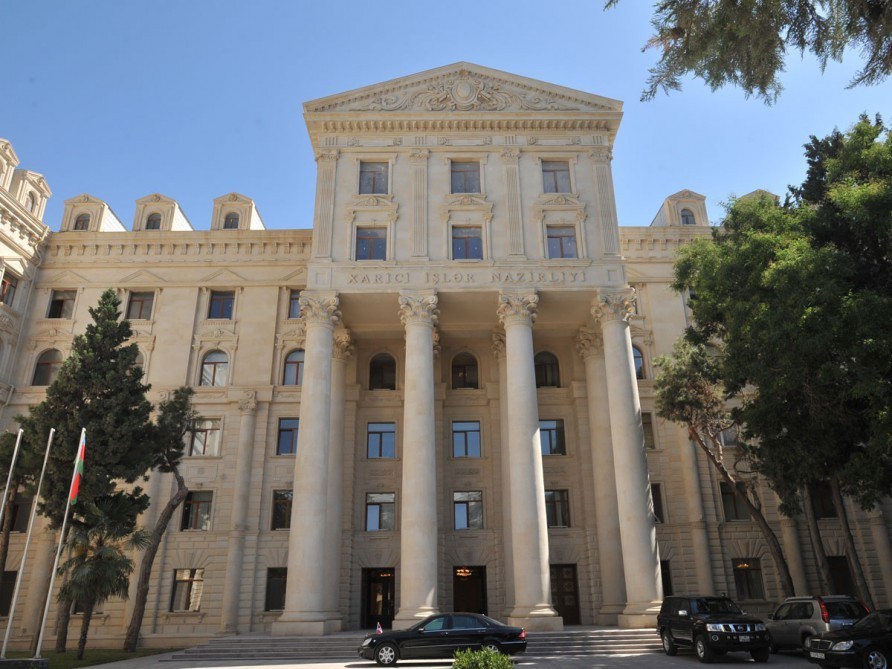“On May 8, 1992, the armed forces of the Republic of Armenia occupied a historical Azerbaijani city of Shusha. As a result of occupation, Shusha city and 30 villages of Shusha district were destroyed, 195 innocent civilians were killed, 165 were wounded and 58 persons went missing.

More than 24.000 inhabitants of Shusha were subjected to ethnic cleansing,” says a statement by Azerbaijan’s Ministry of Foreign Affairs on the 27th anniversary of the occupation of Shusha by Armenia.
“The occupation of Shusha was part of Armenia’s systematic policy of occupation and aggression against Azerbaijan. As an outcome of this policy, Armenia by use of force occupied the Nagorno-Karabakh region and seven adjacent districts of Azerbaijan, conducted notorious ethnic cleansing against more than one million Azerbaijanis in the seized territories and committed other serious war crimes and crimes against humanity.
Along with being an inalienable part of the internationally recognized territory of Azerbaijan, the occupied Shusha city has outstanding historical, cultural, moral and symbolic meaning for the people of Azerbaijan. Occupation of Shusha, known as “Cradle of the Azerbaijani music”, “Conservatory of the Orient” inflicted heavy damage to the cultural, spiritual and moral heritage of the people of Azerbaijan.
In the framework of Armenia’s deliberate policy of destruction, plundering, desecration and embezzlement of cultural and religious heritage of Azerbaijan in the occupied territories, only in Shusha more than 170 buildings with the status of architectural monument, 160 cultural and historical monuments, mosques, rare manuscripts were destroyed and subjected to vandalism or artificial change of their appearance. “Imarat of Panah khan complex” and library, Khan Palace and Karvansaray, Ashaghy Govharagha and Saatly Mosques, Mausoleum of Vagif, Natavan’s House and many others are among them,” the statement says.
“The occupying Armenian side, following the ethnic cleansing conducted in course of Shusha’s occupation, in contradiction to the requirements of international humanitarian law, destroys the historical and cultural heritage of Azerbaijan and gradually changes the cultural image of the city. Thus, about 4 thousand people were illegally resettled in Shusha. The Yukhary Govheraga (Juma) Mosque, built by the order of Govharaga, the daughter of Karabakh ruler Ibrahim Khan, is being “restored” by the Armenians and is presented as a Persian one. All these clearly demonstrate the intentions of the occupiers to shadow the fact that Shusha is a prominent Azerbaijani city.
But all these attempts have no prospects. The Armenian side has to understand that the occupation is temporary and the Nagorno-Karabakh region has always been and will remain inalienable part of Azerbaijan.”
“The visit of the Armenian political leadership to the Shusha city, kept under military occupation by them and celebrating the so-called “victory day” is yet another provocation of the Armenian side and demonstrates once again the direct participation of Armenia in the occupation of the Azerbaijani territories. This step of the Armenian leadership proves once again that Armenia exercises the effective control over the occupied territories of Azerbaijan, as it is confirmed by the ruling of the European Court of Human Rights on “Chiragov and others v. Armenia” case of 16 June 2015.”
The position of the international community is unequivocal: According to the position of all international organizations and states of the world, including the resolutions adopted by the UN Security Council, Nagorno-Karabakh recognized as an integral part of Azerbaijan. The international community requires immediate, complete and unconditional withdrawal of occupying forces from all the occupied territories of Azerbaijan.”
“Azerbaijan is the most interested party in the soonest negotiated settlement of the conflict. However, if the negotiations fail to bring as an outcome withdrawal of the armed forces of Armenia from our occupied lands, Azerbaijan retains its inherent rights under the UN Charter to ensure the restoration of its sovereignty and territorial integrity within the internationally recognized borders,” the statement concludes.










 Inauguration ceremony of President of Azerbaijan Ilham Aliyev was held
Inauguration ceremony of President of Azerbaijan Ilham Aliyev was held Ilham Aliyev wins presidential election with 92.05 percent of votes VIDEO
Ilham Aliyev wins presidential election with 92.05 percent of votes VIDEO President Ilham Aliyev, First Lady Mehriban Aliyeva and family members voted in Khankendi VIDEO
President Ilham Aliyev, First Lady Mehriban Aliyeva and family members voted in Khankendi VIDEO Plenary session of 6th Summit of Conference on Interaction and Confidence Building Measures in Asia gets underway in Astana. President Ilham Aliyev attends the plenary session VIDEO
Plenary session of 6th Summit of Conference on Interaction and Confidence Building Measures in Asia gets underway in Astana. President Ilham Aliyev attends the plenary session VIDEO President Ilham Aliyev was interviewed by Azerbaijani TV channels in Prague VIDEO
President Ilham Aliyev was interviewed by Azerbaijani TV channels in Prague VIDEO














